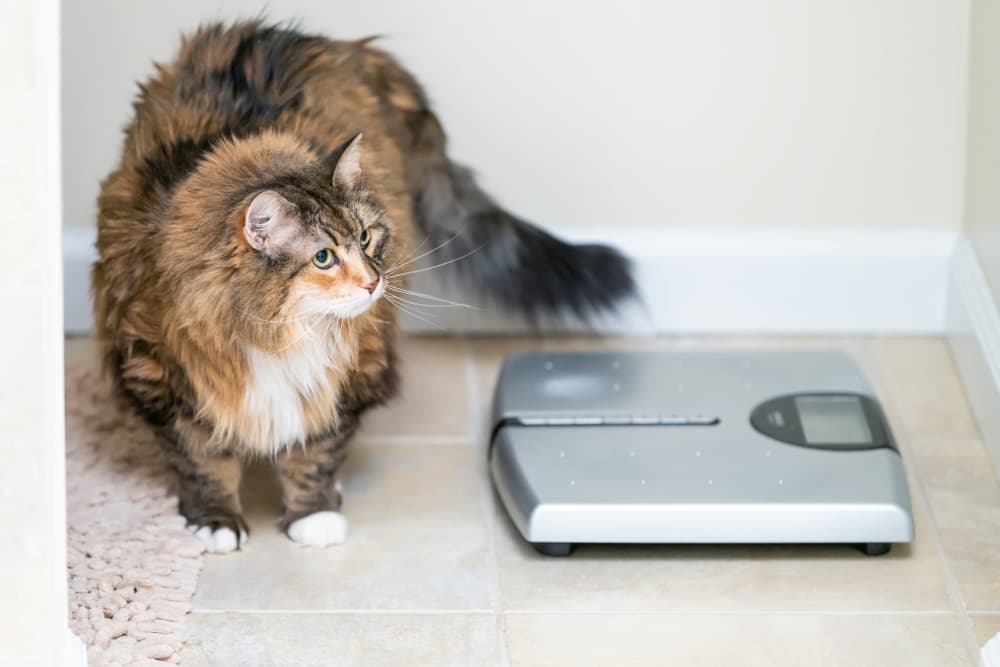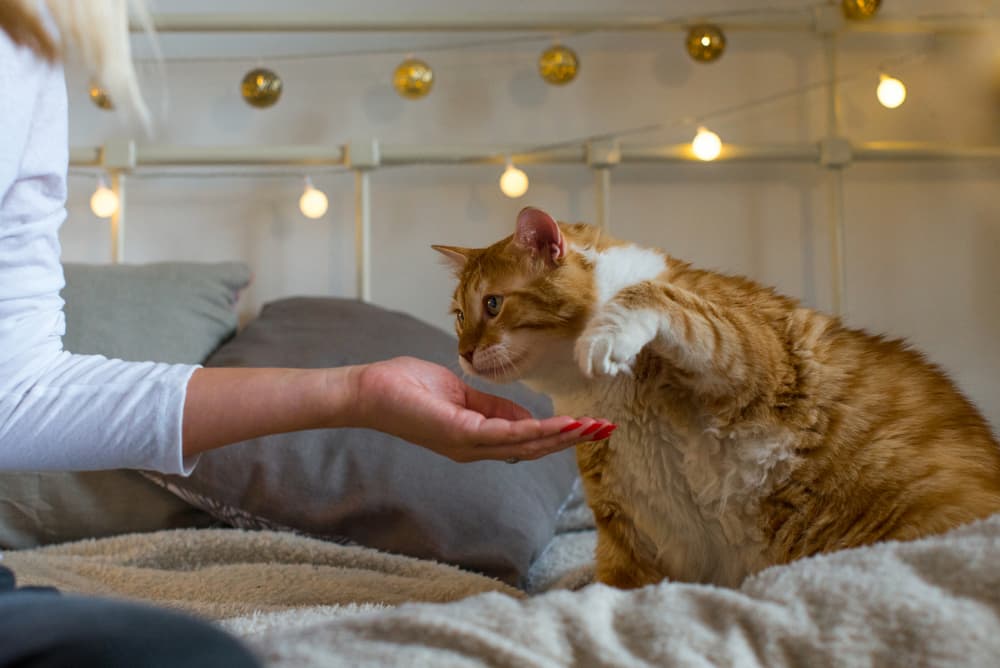How to Help a Cat Lose Weight: 8 Things to Try

Did you know that nearly two-thirds of cats may be overweight or obese (1)? Unfortunately, the more common it is for our pets to be overweight, the easier it is to ignore. In fact, most pet parents think their cat’s body weight is ideal (2), but that’s not the case. It’s just that we’re so used to seeing obese pets, we start to normalize it. But since obesity is associated with many diseases and conditions, including a shorter life expectancy, it’s essential that we reverse the worrying trend of fat cats.
The great news is that, by reading this, you’ve already taken the first step to getting your cat slim again. Recognizing the problem is the first battle. But weight loss in cats can be a long journey, and it can feel very frustrating. Let’s take a closer look at the risks of obesity in cats, plus explore eight useful tips for how to help a cat lose weight.
Understanding Obesity in Cats

Cats are considered overweight when they’re more than 10 percent over their ideal weight, and obese when they’re more than 20 percent over their ideal weight. Because cats vary in size so much, we can’t define a healthy cat weight for every cat—or even for each breed of cat—but vets are well practiced at determining a cat’s ideal weight from feeling their fat reserves. They feel over the ribs, around the abdomen, and along the back for the presence or absence of fat deposits. They can then give the cat a body condition score (BCS).
A body condition score is usually on a scale of 1-9, where 4 and 5 are ideal. On this scale, 6 is a little overweight, and 7, 8, and 9 are obese. This corresponds with 10 percent, 20 percent, 30 percent, and 40 percent over ideal weight, respectively. You may also see BCS being given on a scale of 1-5, but the 1-9 range is easier to use and allows calculation of an ideal weight.
While you can try using the cat weight chart below to evaluate your cat’s body condition at home, it’s best to ask a veterinarian to give your cat a score, too. It’s really common for pet parents to misjudge their cat’s body condition when first starting out. In fact, it takes vets years to get consistently good at giving cats a body condition score. Keep practicing and checking your findings against your vet’s score to help fine-tune your ability.

Overweight Cats: How It Impacts Health
Overweight cats are more likely to suffer from a variety of other diseases. Joint diseases like arthritis and hip dysplasia are more common in obese cats. They’re also more likely to suffer complications with anaesthetics. Death associated with sedation or anaesthesia is nearly three times as likely in heavy cats (1). Other conditions that are more likely in overweight cats include:
- Diabetes mellitus
- Lameness
- Restricted grooming, leading to matted fur and sores
- Poor breathing
- Urinary tract disease
- Skin disease
- Cancer
In addition, overweight cats who stop eating are at high risk for a liver disease called hepatic lipidosis.
8 Ways to Help Your Cat Lose Weight

So, let’s get that weight off! Just like humans, cats who are overweight have a calorie imbalance—they are taking in more calories than they are using. Decreasing the calories going in at the same time as increasing the calories going out is a surefire way to help your cat lose weight. Wondering how to get a cat to lose weight? It can be difficult, but some of these tips might help.
Work out where the weight is coming from
It’s a good idea to take a long hard look at your cat’s diet to determine where their excess calories are coming from. What are they eating? Make a list of their wet food, dry food, treats, and table snacks, as well as anything you hide medication in. Ask all members of the family to be honest about what the cat is being fed to ensure there’s nothing missing. Don’t forget liquids—anything other than water contains calories. If your cat spends a lot of time outside, try following them or knocking on your neighbors’ doors to see if anybody else is feeding them. A “do not feed me” collar is also sometimes useful.
Count the calories
Next, you should ask your vet how many calories your cat should be getting each day. This will be calculated based on your cat’s goal weight, not their current weight. If you bring in a photo of the calorie information on your pet food, your vet will be able to tell you how much to feed your cat each day.
One important reminder that’s easy to overlook: If your cat enjoys the occasional (or regular) treat, don’t forget to include calories from treats in your daily totals. Some commercial treats can be highly caloric, so don’t be surprised if those calories add up quickly.
Some pet parents may find it easier to eliminate treats rather than limit them. However, if your cat is a treat fiend, you can look for lower-calorie cat treats or those that are formulated to promote weight loss, such as Nutrisentials Lean Treats, Purina Pro Plan Veterinary Diets Crunchy Bites Cat Treats, or Royal Canin Satiety Treats for Cats.



Weigh your cat’s food

If you’ve been using a cup to measure your cat’s food (or worse, simply filling the bowl and leaving it down!), it’s time to start getting more accurate with your cat’s kibble. It’s easy to overfeed cats using a measuring cup, as small variations in how the kibble sits will change how much you feed. Instead, weigh your cat’s food on a kitchen scale. If that sounds too complicated, you can sit down on a Sunday and weigh out the food for the week into individually labeled bags. That way you will also know if the cat has been fed. In a busy house, accidentally double-feeding a cat accounts for a lot of weight gain!
Consider a prescription diet food
Feeding your cat smaller portions of their regular food might sound like a good weight loss tactic to many pet parents. However, because standard cat food is carefully balanced to maintain your cat’s weight, feeding your cat less than the recommended allowance could create a nutritional imbalance.
Some cats will gain weight even when fed the recommended amount on the standard food bag. That’s why many veterinarians recommend weight management cat food options that are specifically formulated to support your cat’s weight loss and nutrition needs.
Weight management cat foods work in several ways. Firstly, they help your cat feel fuller, so they’ll pester less for food. And secondly, they contain ingredients to kickstart your cat’s metabolism. They’re less calorific than most foods too, containing lots of low-calorie fiber. This means your cat’s bowl should look as full as it usually does.
Depending on your cat’s specific weight management needs, your veterinarian may recommend a prescription formula, such as Hill’s Prescription Diet Metabolic Weight Management Cat Food or Royal Canin Satiety Support Weight Management Cat Food. These diets are available only with a veterinarian’s approval.


There are also effective weight management diets you can purchase over the counter without a prescription, such as Royal Canin Weight Care Cat Food or Hill’s Science Diet Perfect Weight Cat Food. However, you should always work with your veterinarian before switching your cat’s diet, to ensure you’re making the best choice for your pet’s long-term weight management goals.


Discover more veterinarian-approved weight management cat food options, along with the pros and cons of each formula, here.
Feed them zucchini
One outside-the-box tip is to feed your cat zucchini. This low-calorie food is high in water, helping cats feel full. Most cats prefer it boiled, but you can also try feeding it raw. Add it to their usual food or as a snack in the middle of the day. It’s a strange tip, but it has come straight from the specialist pet weight-loss team at the University of Liverpool.
Slow down your cat’s eating
Just like us, cats who gulp their food can still feel hungry. It takes a while for the body to register its fullness and produce the hormones needed to give feedback to the brain to stop looking for food.
One easy way to help your cat feel more satisfied is to find ways to slow them down at mealtime so they’re not eating too fast. You can sprinkle dry cat food over a hard floor or hide it around the house in small piles. Puzzle-feeding toys are also great ways to force your cat to take their time while eating and provide mental stimulation at the same time!

Encourage exercise

An exercise routine for a cat may sound crazy, but it’s the only way to increase calorie usage. Try playing with your cat, setting up a cat obstacle course, or putting their food in a puzzle feeder. You can even take them for a walk on a harness, if they’re up for it.
Whatever works, stick with it—but keep it fun and engaging. Never force your cat to exercise, especially if they show any signs of pain or discomfort. (For cats, that could include hiding to avoid playtime.)
If you suspect your cat is in pain, be sure to consult with your veterinarian. Depending on your cat’s specific health needs, your vet may prescribe a medication to help alleviate pain so they can tolerate low-impact exercise. Or they may recommend a hip and joint supplement to help improve joint function.



Keep going back to your vet
Whether you need the repeat appointments for accountability or support, going back to your vet for regular weigh-ins is much more likely to result in weight loss. They’ll be able to help you if your cat’s progress stalls and remind you of how far you’ve come, which are both important to keep you moving in the right direction. The good news is that many practices will offer these appointments free or at a reduced rate so you can go back as often as you need to to ensure your cat is healthy and happy.
Weight Loss Safety for Cats

It’s very important that you are careful with your cat’s weight loss diet. It’s best to talk to a vet before starting a weight loss journey to ensure your cat is healthy and to discuss your target weight to make sure it is appropriate. They’ll also be able to advise you on how much you should feed your cat for safe weight loss. It’s very important not to try to get your cat to lose weight too quickly. Sudden calorie deficit can cause cats to mobilize fat stores, leading to hepatic lipidosis, which can be life-threatening.
It’s very common for cats to become overweight, but with a little help from your veterinarian, you can get them back to full fitness. The key with cats is not to lose hope—weight loss for cats is (and should be!) slow. It should take a minimum of six months to reach a healthy weight and in very overweight cats, it can take several years.

References
- Zähringer, Dagmar & Story, Michelle & Rand, Jacquie & Svoboda, Miroslav. (2016). Feline obesity – prevalence, risk factors, pathogenesis, associated conditions and assessment: A review. Veterinární Medicína. 61. 295-307. 10.17221/145/2015-VETMED.
- PAW PDSA Animal Wellbeing Report 2020. 10th Edition. Retrieved from https://www.pdsa.org.uk/media/10540/pdsa-paw-report-2020.pdf









